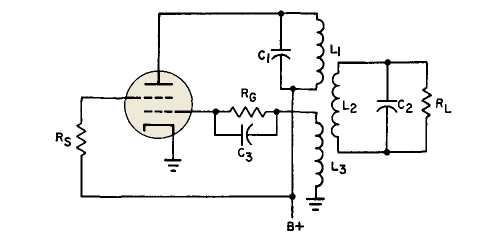| Electronic Transformers and Circuits is a free introductory textbook on transformers and related circuits. See the editorial for more information.... |

|

Home  Higher-Frequency Transformers Higher-Frequency Transformers  High-Frequency Power Supplies High-Frequency Power Supplies |
||||||||
| See also: Power Supply Frequency | ||||||||






|
||||||||
High-Frequency Power Supplies
In cathode-ray tubes for oscilloscopes or television receivers, high-voltage low-current sources of d-c power are needed for the accelerating anodes. Voltages range from 1 to 30 kv, and currents are on the order of 1 ma down to 1 μa. Because of the many turns of wire required in high-voltage 60-cycle transformers, high-frequency power supplies are often used. A tetrode or pentode tube is used in a double-tuned circuit as shown in Fig. 182.
Here the plate circuit is tuned by means of elements L1 - C1 and the load circuit by means of L2 - C2. The grid winding is coupled from L1. The coupling between L1 and L2 is usually higher than critical, so that changes in load do not affect the resonant frequencies, but instead vary the relative height of the two humps.
Frequencies used in such power supplies range from audio to medium high radio frequency. The oscillator is usually operated class B or C; loaded Q (or ratio of volt-amperes to watts) ranges from 10 to 20. Lower values of Q result in oscillator instability with load changes. With ferrite cores, departures from the overcoupled case are feasible. Frequency is usually lower than with air-core transformers. The core itself affords a certain amount of load to the circuit and therefore results in better voltage regulation from load-on to load-off conditions. The single-tuned oscillator of Fig. 152 then becomes practical.
|
||||||||
Home  Higher-Frequency Transformers Higher-Frequency Transformers  High-Frequency Power Supplies High-Frequency Power Supplies |
||||||||
Last Update: 2011-02-17


